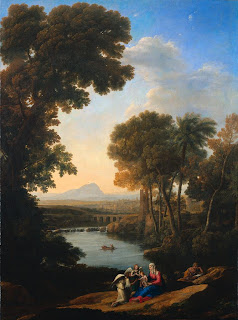What is the Picturesque?
The picturesque is a term used to describe certain properties of Landscape views in reality or as depicted in visual arts. The word itself originates from the Italian word "pittoresco", which is translated: "as in a picture" or "as if in a picture".
During the entire history of the picturesque there was never a clear definition of what the picturesque was exactly. Different artists described the properties of the picturesque in different ways.
William Gilpin (1724-1805) had a recipie for the Picturesque which at the time was both accepted and disputed but his concepts are still the central influence to what we perceive as picturesque today.
It could be argued that the picturesque is an invention of the british, who where amongst the first 'tourists' and that picturesque originates from the art of the picturesque travel which became popular in the 18th century at first on the continent and especially Italy where crumbling roman architecture was a favourite subject. The picturesque marks the beginning of tourism which is connected with the habit and desire to view places and landscapes in pictures.
The picturesque was based on a changing idea about nature, To see beauty and and a positive value in the irregular forms of Nature was new and modern. The paintings of Claude Lorrain (1600 - 1687) see below. and Nicholas Poussin (1594 - 1665) had set the standards with a strong influence in visual arts. By the the middle of the 18th Century Edmund Burke had developed a strong theory on beauty and the sublime, the picturesque however was much more difficult to define. The picturesque was an irrational pleasing synthesis of often contradicting catogories. It could be said that the picturesque fitted the aesthetic category between the classically beautiful and the awe inspiring sublime.
As mentioned earlier, a recipe for the picturesque was developed by William Gilpin in the late 18th century. Gilpins essays on Picturesque beauty and on Picturesque travel refer to E.Burke and his theory of beauty. According to Burke beautiful subjects are neat and in particular smooth. Smoothness is considered essential to beautiful subjects.
............to be continuedThe Lorrain Effect

Lorrain’s Rest on the Flight into Egypt, 1644: As well as being an idealised and evocative landscape, this typical combination of composition and lighting by Lorrain acts like a stage set, with the two dark wings taking the eye through to the distance — but it quickly returns to the pool of light containing the group of figures
Claude Lorrain, one of the first great landscape painters in the 17th century.
"One of Lorrain’s most distinctive treatments goes as follows. A dark, shadowed foreground, weighted and partly framed to one side with trees. On the other side, and a little beyond, another framing mass, not quite as dark. The landscape becomes a kind of stage set. Beyond, the landscape receding to the horizon becomes lighter and lighter, and the sky lighter still, because the view is into the sun. This structure and lighting takes the eye from the foreground on one side across and beyond to the middle ground, and then towards the luminous distance and sky in the centre and slightly above. The image has structure, and leads the eye"
Michael Freeman http://thefreemanview.com/techniques/the-lorrain-effect/
http://www.tate.org.uk/britain/exhibitions/turnerandthemasters/default.shtm
